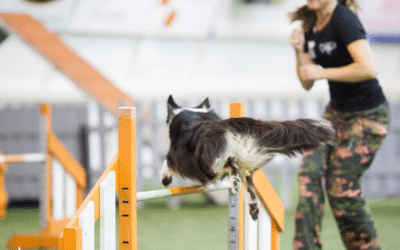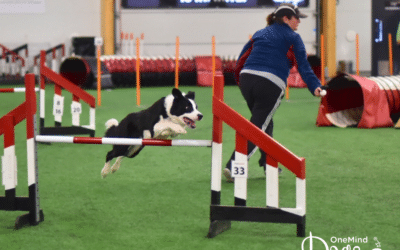Hey there, agility enthusiasts! Today, we’re discussing the role of verbals in dog agility and, specifically, in the OneMind Dogs method. If you’ve ever wondered whether or not OneMind Dogs handlers use verbal cues, you’re not alone. In the OneMind Dogs method, we do use verbal cues! Read on to find out how verbal cues fit within our method and what dogs have taught us about using verbals in our handling.
Dogs are our best teachers
Dogs have taught us so much about how they understand body language and how they make decisions based on subtle changes in how we move. Thanks to the thousands of dogs we’ve worked with and learned from, we know body language is the strongest form of communication for them.
Click here to learn more about how a deaf dog taught us how to listen and find out about Tekla, the dog who started it all!
Dogs have also taught us about how they read our specific body language in life, which led to one of the core concepts of our method: The 7 Handling Elements:
- Motion
- Position
- Eyes
- Chest
- Legs
- Arms
- Voice
The 7 Handling Elements are listed in order of importance to the dogs, with the last two being the least important. This means that you can technically run agility without using your arms or your voice and the dog will still have an idea where to go based on the other 5 elements. This is why deaf dogs are still able to participate in agility! This also means that for us, verbal cues play a supporting role to the other handling elements. In this way, all 7 handling elements give the dog the same message.
Adding verbals to support your handling in agility
Verbal cues are useful and good to have in your agility toolkit to support and enhance your handling. When all 7 Handling Elements say the same thing, the message is clear for the dog.
For example, did you know you can add a verbal cue to handling techniques such as backside send, rear cross, or flick? Simply by choosing a verbal cue and adding it to your handling, your dog will put together that your chosen verbal cue goes with the handling they see. Adding verbal cues in this way helps the dog confidently perform the line, even at bigger distances, because all 7 elements give them the same message.
Here are some examples of verbal cues we use with these agility handling techniques:
Rear cross: switch or cross (directional cue as well “Left/Right”)
Backside send: Back, Push, or Around
Flick: Way, Turn, Zip-Zip or Seek
Evolving Agility Courses
Agility courses have new challenges these days, such as more speed, longer lines, turns away from the handler, and obstacle discrimination. Add to that the popularity of running dog walks, and we face new and interesting challenges! Training verbals in support of handling can help on these types of lines, as well as in situations where maybe your handling isn’t quite perfect and that little bit of verbal support helps your dog confirm that they are correct.
One of the core concepts behind OneMind Dogs is that “Learning is infinite”. The founders of the OneMind Dogs method are constantly learning — from dogs, other trainers, competitors, judges, and each other. As a result, the handling and training techniques behind the OneMind Dogs method are constantly evolving.
This means that our method stays relevant for general dog owners and agility competitors alike. We’ve adapted techniques to be used at more distance, or added opposite hand to further support lead leg changes, and those are just two examples! With the popularity of running dog walks, we’re also learning about the role of verbals in support of dog walk exit lines when the handler is likely to be far behind the dog.
OneMind Dogs method and the use of verbals in agility
At OneMind Dogs, we believe that verbal cues should complement your other handling elements as much as possible. Dogs have taught us that it’s easiest for them to understand body language (their natural language), but they can learn verbals as a second language that supports their natural language. This is related to how dogs perceive the world. Similar to a human learning a foreign language, if someone repeats an unfamiliar word without context, you will feel a bit confused. If that same person were to, for example, point to an object or do a gesture while saying the word, you would start to associate the word with the object. However, it will still be some time before you generalize that foreign word with the meaning. Dogs are the same way.
Things to consider when teaching verbals in agility
Be mindful that verbals require training, repetition and daily maintenance, to keep the understanding strong for the dog. When the understanding is lacking the dogs will revert to what they follow naturally. Similar to training a stopped contact, sufficient proofing is required before taking that verbal show on the road… aka putting it into coursework!
When training and using verbal cues, it’s also important to keep in mind that if you correct the dog for instinctively following your body language, it may lead to confusion for them. That’s why understanding the dog’s perspective of handling and agility is super important. If your dog appears to be ignoring your verbal commands, you can always freeze and check if your other elements support the verbal, rather than repeating the exercise multiple times to “make” the dog listen.
Understanding the dog’s perspective and natural communication will help your verbal training go smoothly, as well as keep your relationship with your dog at its best. Clarity in training leads to faster learning, more confidence, and more fun!
Handle lines
In the OneMind Dogs method, we use obstacle names as verbal cues. This helps us in discriminations such as contact-tunnel, where we can simply verbally cue the dog to find the contact and keep running, or add pressure to the line and ask them to find the tunnel. We also use verbals that focus on what happens between obstacles. For example:
- Go Forward: Go, Go on, or run
- Collection cue: check , tight , wrap, dig-dig
- Slow down: shh, whoa, or easy – For example Tunnel Brake
- Run to me/Come to me: Come or Here
- Backside: Push, Back, or Around
Tips for using verbals to support your handling in agility
- All 7 Handling Elements should support the same thing. If you’re using verbals to support your handling, always check that the first 6 elements are giving the same message you intend for the verbal.
- Keep it simple. Decide what verbal cues your team really needs, and keep them simple to define. Can you explain what the verbal means from your dog’s perspective? If not, the cue is probably too complex or too confusing. Clarity is key.
- Proof your training. Determining whether your dog truly understands a verbal cue the way you intended, especially for obstacle commands like “weave” is also an important consideration. Can your dog follow the cue when you stand still, run at top speed, run backwards, or when there’s a potential distraction nearby? Can they make the right choice consistently, even in either-or training scenarios? Try this fun weave challenge to proof your weave training!
- Timing: Verbal cues should be given early so the dog has time to process them. For example, is there a set of weaves after a tunnel? Say weave when your dog is committed to the tunnel, 1 meter / 3 feet before they go in.
- Ensure your verbals don’t sound similar to each-other. For example: If your dog is named Bo, and your go-forward verbal is “Go”, this might be confusing for the dog because the words sound so similar.
Conclusion
In summary, the OneMind Dogs method focuses on understanding the dog’s perspective and on teaching handlers to communicate in the language dogs naturally understand—body language. Our method is flexible and easily adaptable to all kinds of dogs and handlers; nothing is ever set in stone. Verbal cues definitely have their place within our method, but they should support your other handling elements. It’s all about finding the right balance and what works best for you and your dog. Need help? Send us a video, and we’ll give you more insight from your dog’s perspective!
Happy training 🐾



